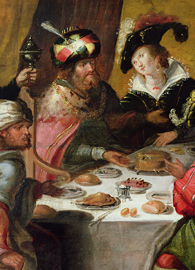1 Corinthians Week 8
Called to … Proper Worship: 1 Corinthians 11:2–34
Seattle Pacific University Professor of Educational Ministry
Read this week’s Scripture: 1 Corinthians 11:2-34
16:09

 Enlarge
Enlarge
Although this week’s Lectio passage does not open with “Now concerning,” Paul most likely is still responding to concerns raised by the Corinthians. In fact, two concerns are addressed by Paul in this passage, and both have to do with proper behavior in the context of worship. The first (1 Corinthians 11:2–16) seems to be a matter of “manners;” the second (11:17–34) a matter of “morals.” We will examine each concern in turn.
To Cover Up … or Not (11:2–16)
You most likely know of the Rorschach inkblot test. Created by Swiss psychiatrist Hermann Rorschach in 1921, the test presents subjects with 10 ambiguously shaped inkblots. Subjects are then asked to describe what they see. The inkblot functions as a “blank slate,” onto which subjects project their thoughts, beliefs, and perspectives.
Why mention this? Well, I am convinced that 1 Corinthians 11:2–16 should carry a warning label: “The section you are about to read is the Rorschach inkblot of Paul’s letter to Corinth.” The text is ambiguous and complex. As a result, interpreters have made all kinds of claims about what this text teaches. [see Author’s Note 1] As your guide, my goal is to help you notice the ambiguities and offer a possible path through them.
The specific issue seems fairly clear: How should church members, male and female, “dress” when they pray and prophesy in worship services? (11:5) Paul mentions men’s attire (11:4 and 11:7), but mostly to show the difference he expects between men and women.
The debate seems primarily focused on how women should dress when they pray and prophesy in church. The particular “dress code” at stake was whether women should wear a covering on their head. Paul’s counsel is clear. Women should cover their heads when praying and prophesying; men should pray and prophesy with their heads uncovered. The exact nature of the covering is not clear. Are we talking about hats, veils, or the person’s actual hair?
It appears from the discussion about shaved heads (11:5) and long hair (11:14–15) that Paul’s primary concern is how women are wearing their hair — “tied up” or “let down.” Paul is convinced women should have their hair “tied up” in worship. He appeals to nature, theology, and customary practices to persuade his readers.
The argument from nature. Arguments from nature move from “the way things are” to “the way things should be.” Paul essentially makes this argument (11:14–15). He finds it natural for men to have short hair and women to have long hair. To reverse this natural condition would be shameful and degrading to men and women. Paul believes it blurs the boundaries between men and women and deprives women of their natural head covering.
We might say it is “natural” to make arguments from nature, but they carry a two-fold risk.
- Risk #1: We don’t always know how things really are. What seems natural to us may not seem natural in a different place and time.
- Risk #2: We seldom make this move with consistency. We make the move in some situations, but don’t make the move in others.
For example, facial hair may seem “natural” for men, but in some ethnic groups men grow very little facial hair (Risk #1). If a man can grow facial hair, should he not shave in order to preserve his natural state? Few would make that case (Risk #2).
The argument from theology. Paul makes two theological claims [see Author’s Note 2] to bolster his instructions for women to wear head coverings in worship.
- First, Paul sees a hierarchical order of creation: God, Christ, men, women. [see Author’s Note 3] Paul finds head coverings for women a symbolically appropriate manner of showing respect for this order.
- Second, Paul appeals to the creation account in Genesis 2, where the creation of Adam precedes the creation of Eve. This counts as evidence for Paul’s perspective on creation’s order, because it shows that Eve was created for Adam’s sake, not Adam for Eve’s sake (11:9). He infers from this sequence that males reflect God’s image and glory; females reflect male’s glory (11:7).
Theological arguments also carry some risk, and Paul seems to recognize it. Paul’s primary concern is preserving a symbolic distinction between men and women in the context of worship. He appeals to a biblical story that supports his point, yet makes no mention of God’s creating “humankind in his own image … male and female created he them.” (Genesis 1:27)
This account of the first humans would provide a corrective to Paul’s sense of creation’s order. Interestingly enough, Paul seems to recognize the need for a corrective, because in 1 Corinthians 11:11–12 he says, “Nevertheless, in the Lord woman is not independent of man or man independent of woman. For just as woman came from man, so man comes through woman; but all things come through God.” Life “in the Lord,” not “creation order,” is Paul’s primary orienting concern in these verses. “In the Lord” there is equal standing and mutuality between women and men. Though he finally wants to maintain a distinction between men and women in worship and even offers a theological claim in support, Paul seems to recognize that “in the Lord” hierarchy may not have the final word.
The customary practice argument. Perhaps this diffidence in Paul is evident in his closing argument, which is really not much of an argument. Paul simply says, “[I]f anyone is disposed to be contentious — we have no such custom, nor do the churches of God” (11:16). The word for custom in Greek is synetheia, best translated “customary practice” – a matter of manners.
Think of that common parental explanation to a child, “Honey, that’s just the way we do it in our family!” Such a claim does not inspire confidence that the parent is speaking an absolute truth intended for all time!
To Eat … or Wait (11:17–34)
If wearing a covering in worship was a matter of manners, Paul’s next concern is clearly a matter of morals. The issue is serious enough to earn Paul’s rebuke (11:17). Their behavior demonstrates contempt for the church and humiliation towards church members (11:22). Paul is convinced the behavior has brought God’s judgment on the church (11:29–30).
What moral offence has Paul fired up? Basically, some Corinthian believers were charging to the front of the food line at the Lord’s Supper. Here’s the story.
Contrary to typical practice today, the Lord’s Supper in Paul’s time was a “full-meal deal.” As a means of promoting community and sharing (Acts 2:42–47), churches practiced common meals. Think church potlucks! Church members would bring dishes to share. In the course of the meal, the Lord’s Supper would be celebrated. Because of the Corinthians’ abuse, we get a brief glimpse into the celebration (1 Corinthians 11:23–26), but Paul’s primary point was to correct the abuse.
The abuse seems clear. Some church members were arriving early with their food and drink. Rather than wait for everyone to arrive, these early birds started eating and drinking — and didn’t stop until the food was gone and some were drunk (11:21). As a result, late arrivals were left with nothing. We should note that “arrival time” probably intersected economic class. Those who could knock off work early were likely better off economically. Those who were servant-class and “on the clock” likely arrived later.
Paul finds the behavior reprehensible and is even more troubled that the Corinthians can’t see that such behavior undermines the very notion of the Lord’s Supper. In fact, it is so unworthy of what the Lord’s Supper means (11:27) that it is not really the Lord’s Supper (11:20). Paul calls the Corinthians to “discern the body,” which is a polite way of saying, “For goodness sake, look around and see what you are doing to each other! You are making a mess of sacred matters.”
Paul closes the section with a practical solution that assumes the best about the cause of their misbehavior. Again, to paraphrase, “Look! If you are so hungry that you have to dive into the spaghetti before everyone arrives, eat a snack before you come together.”
So What?
Long hair. Head coverings. Pigging out at church potlucks. How can we connect to this portion of Paul’s letter? What imaginative work can we do to hear God’s word for our lives so that we can be strengthened to the end (1:8)? Let me suggest two phrases in this passage to ignite our thinking: “In the Lord” and “discern the body.”
In the Lord. Paul understands that life “in the Lord” changes our life “in the world.” This does not mean a complete rejection of the world’s ways and practices, but it does alter our perspective and practices. Paul advocates the customary symbolic distinction between men and women, but rejects any distinctions in what men and women do in worship. “In the Lord” both women and men pray and prophesy (11:4–5). “In the Lord” there is mutuality and interdependence (11:11). How does our life “in the Lord” change our perspective and practices?
Discern the body. Paul’s admonition to discern the body is essentially, “Pay attention!” Paul is convinced that careful attention to the effects of behavior will help the Corinthians see where their life together fails to embody the meaning of the Lord’s Supper. Are we paying attention to life in our local congregations? Are we discerning how to be the body of Christ?
Questions for Further Reflection
- Paul calls upon the Corinthians to “discern the body.” Consider the local congregation to which you belong. In what ways is it a healthy body? How might its life together be strengthened?
- How has life “in the Lord” changed your perspective and practices?
- What meanings do you find in receiving the Lord’s Supper? What does it mean to receive it in a worthy manner?
<<Previous Lectio Back to 1 Corinthians Next Lectio>>

This work is licensed under a Creative Commons License.





Personally, I believe that Paul is quoting a faction of men who wrote him in verses 4-6. There are two reasons why I believe that verses 4-6 are quoted. The first reason is that the rebuttal portion (vss. 7-16) completely contradicts the quoted portion (vss. 4-6). (Note: Unfortunately most people do not undertand that verses 7-16 contradict verses 4-6 because the translators have added words in the rebuttal portion (that are not in the original Greek) in an attempt to harmonize it with the quoted portion.) And the second reason is that Jesus Christ (not man) is the image and glory of God. (See 2 Corinthians 4:3-4, Colossians 1:15, Hebrews 1:3, Revelation 21:23.) Paul, in verse 7, is using Jesus Christ as a correlation as to why women should not be veiled. So Paul ingeniously places the mens words (vss. 4-6) in between his model (vs. 3) and rebuttal (vss. 7-16) to explain exactly why women are not to be veiled. Anyway, this is just what I believe. Take care and God bless.